| September 3, 2009
The Great North American
Loudspeaker Tour: Verity Audio
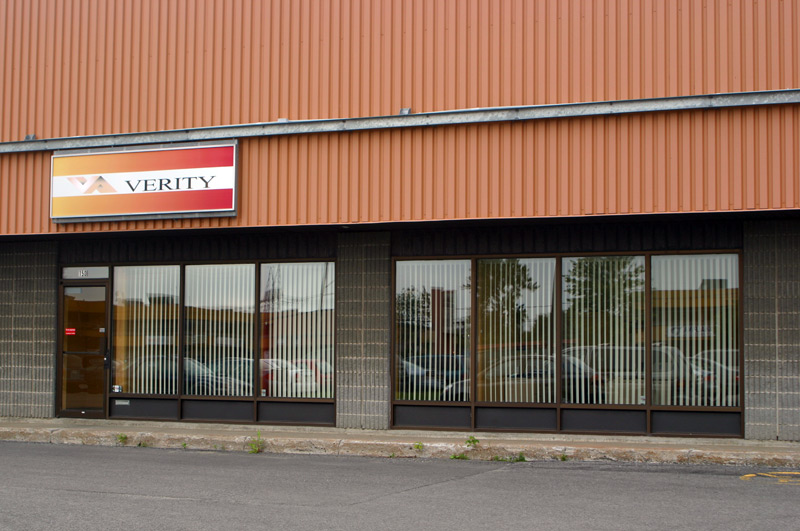
The entrance of the Verity Audio factory in Quebec City, Canada.
Main designers: Bruno Bouchard and Julien
Pelchat
Product auditioned: Lohengrin II loudspeaker
($80,000 USD per pair in piano black; optional painted and wood-veneer finishes are
available at extra cost)
Associated Equipment
- Amplifiers (all monoblocks): Wavac HE-833 Ver1.3,
Nagra VPA, Tenor 350M
- Preamplifier: Nagra PL-L
- Sources: dCS Scarlatti SACD/CD transport, Scarlatti
Master Clock, Scarlatti DAC; Nagra DII digital tape recorder
- Cables: Nordost
- Power conditioner: Vibex
Setup details: The Tenor (350W), Wavac (150W), and
Nagra (50W) amplifiers were used in succession to illustrate how the 95dB-sensitive
Lohengrin IIs sounded with amplifiers of various power outputs.
Listening room: Verity Audio’s listening room
is 30’L x 18’W x 11’H, with polycylindrical diffusers hung from the ceiling
on short chains, as well as many bass traps and wall panels from Echo Busters. Large
record shelves line the room’s rear wall; equipment is placed on short racks in front
of the listening seats, within arm’s reach.
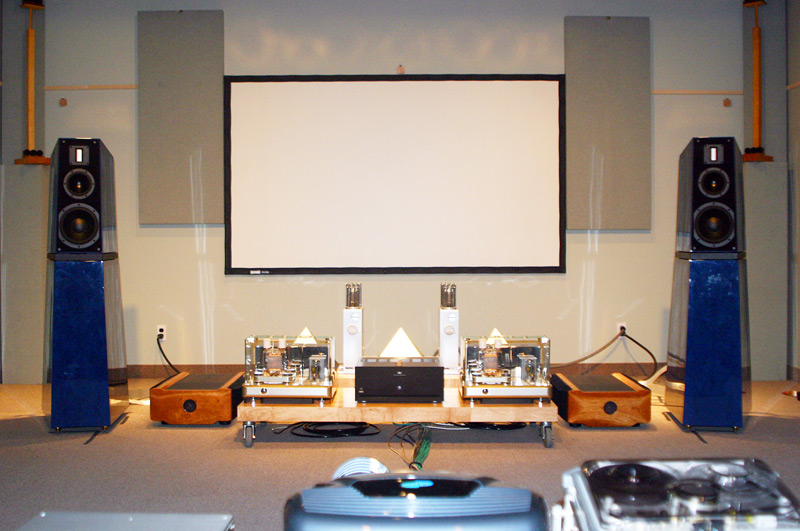
The Lohengrin II loudspeakers, finished in blue, set up in Verity Audio’s
factory listening room.
Julien Pelchat and Bruno Bouchard’s vision for the
Lohengrin II: The Lohengrin II should have "deep bass extension," "high
sensitivity," and "wide bandwidth" that extends as high as 100kHz. It
should be a speaker that can fill a much larger room than, say, their smaller Parsifal
model. Verity "re-optimized every aspect of design" of the original Lohengrin to
come up with the II, including replacing the Raven ribbon tweeter with a model they make
in-house.
According to Julien Pelchat and Bruno Bouchard, the
Lohengrin II is most suited to: The Lohengrin II is designed for real-world
environments -- i.e., the actual homes of end users. Therefore, it was important
that the speaker be "easy to place," and that it "work with the room, not
against it." Although the Lohengrin can overload a small room with too much bass, it
is very flexible in terms of setup, and doesn’t need massive amounts of power to be
driven to realistic output levels.
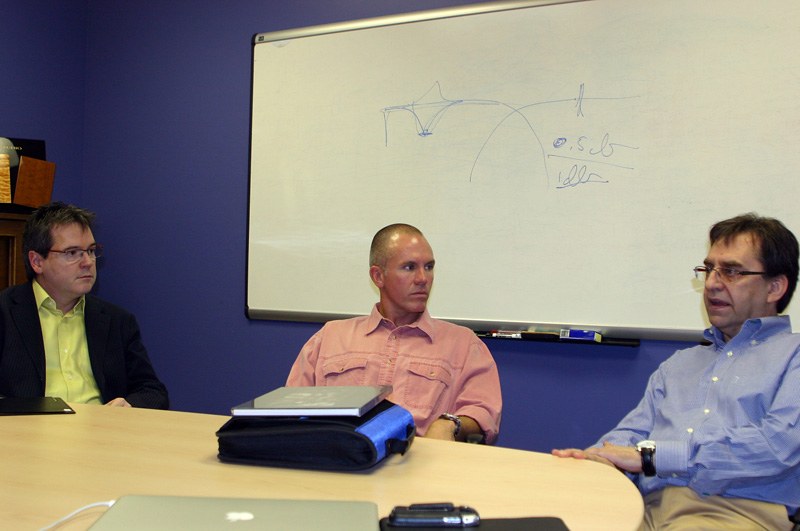
Bruno Bouchard (left) and Julien Pelchat (right) start the day by talking with
Jeff Fritz about the main design goals by which they guide Verity Audio.
Listening impressions
Musical selections included cuts from Jeff Beck and Chick
Corea (24-bit/96kHz master tapes played on the Nagra DII) to CD tracks from Peter Gabriel,
Diana Krall, Loreena McKennitt, Jeff Buckley, Rosanne Cash, and many others.
The Lohengrin II is noted for its 95dB sensitivity rating,
which indicates that the speakers come to musical life at very low listening levels
without requiring a great deal of power from the amplifier. It had a unique ability to
reproduce ultradetailed, full-range sound when playing almost whisper-quiet, but could
also scale with the music, delivering wide dynamic range when the program material called
for it. I marveled at the Lohengrin II’s ability to reproduce all manner of bass
instruments with fastidious articulation. Its way with bass was like a world-class sports
car hugging a winding road. The highest frequencies, though not calling attention to
themselves when the music was heavy in the midrange and bass, portrayed microdynamic
musical shifts with tremendous subtlety. Percussion tracks had great impact in the low and
midbass frequencies, but Verity’s proprietary ribbon tweeter was both extended and
delicate, portraying the minute dynamic shifts of cymbals with precision and spot-on
tonality.
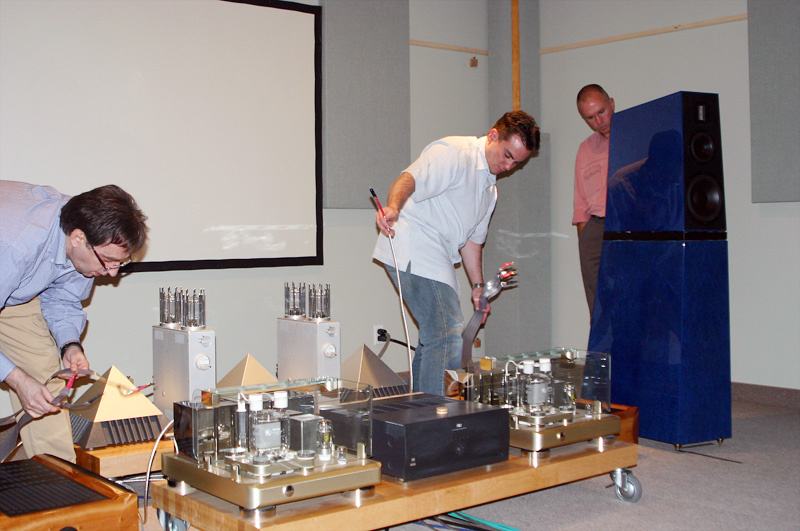
Part of the listening session was spent comparing the sound using various amps
that Verity keeps on hand at the factory. John Quick (center), Verity’s US sales rep,
helped with setup.
The ability to play small-scale music and subtle
arrangements was equaled by the Lohengrin II’s ability to reproduce larger-scale
recordings with huge dynamic swings. The chorus on Marianne Mellnäs’s
performance of "O Holy Night," from Cantate Domino (SACD/CD, Proprius
PRSACD 7762), swelled in the Verity listening room, easily extending in width from one
sidewall to the other when, shortly into the song, Mellnäs is joined by the chorus. The
soundstage depth was equally impressive, the singers layered deeply and with proper
height. The bass response was sufficiently deep to re-create a tremendous sense of space
with this track, capturing the recording venue easily.
The 24/96 tracks played back on the Nagra DII were
breathtaking. The Lohengrin IIs seemed right at home reproducing this
greater-than-CD-resolution material. The ribbon tweeter, particularly, could display fine
detail with tremendous ease and transparency. A master tape of Jeff Beck playing guitar at
the Montreux Jazz Festival was reproduced with a huge dose of clarity and dynamic scaling
that made it sound very close to real life.
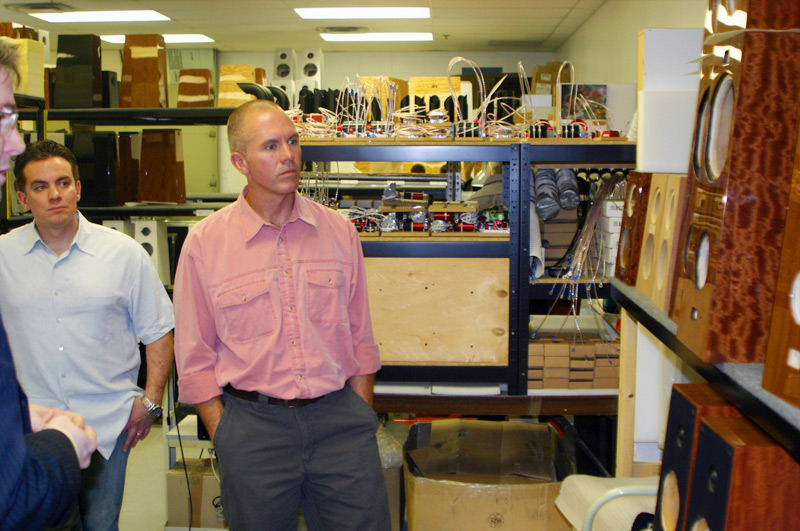
Verity Audio takes great pride in the quality of its cabinetry and the aesthetic
appeal of each loudspeaker.
Company impressions
Bruno Bouchard and Julien Pelchat have very specific
sonic goals for their products, and appear to have a deep understanding of loudspeaker
design that does not keep them from questioning established audio principles at every
turn. Although they cut against the grain in terms of some of their design choices -- such
as running their midrange drivers up to 4.5kHz to 6.5kHz, depending on the speaker model
-- they make such choices knowing full well how they will impact both the measured
responses of their loudspeakers and the listening experience. Keeping the crossover points
out of the critical midrange and keeping the speakers very sensitive are two things that
create the trademark Verity sound, which has garnered a loyal following of customers
around the world.
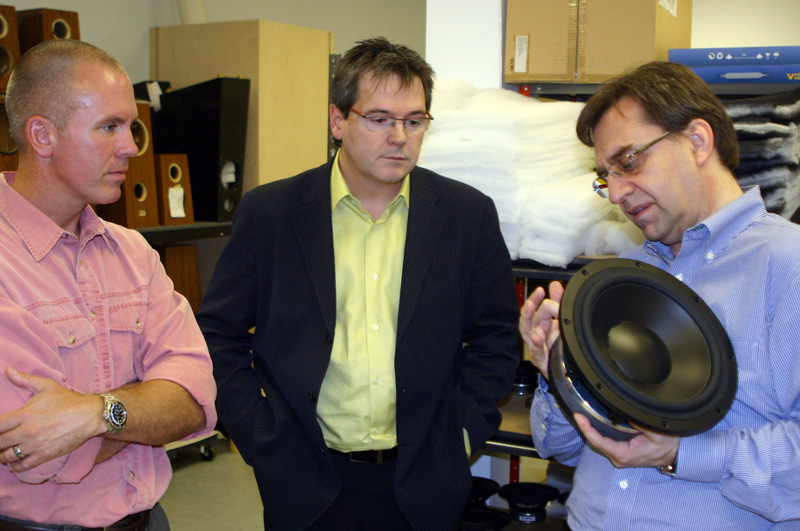
Julien explains what they look for in the drivers they select for each speaker
design.
Conclusion
Companies that have a clear vision of the product they want
to make before they set out to design, manufacture, and market it are typically tightly
focused and goal-oriented. Verity Audio has built a line of loudspeakers that all share a
unique family resemblance in terms of sound, appearance, and technical design. Each model
is rightly considered compact in size and elegant in appearance when compared with most
other competing speakers.
Lastly, the company’s principals share a deep passion
and respect for music that are clearly reflected in their products, and our many hours of
listening didn’t comprise a typical audio demonstration. Julien Pelchat and
Bruno Bouchard reveled in and marveled at the music their Lohengrin IIs were
making, and so did I -- until that wonderful day ended, and I was off to the airport
again.
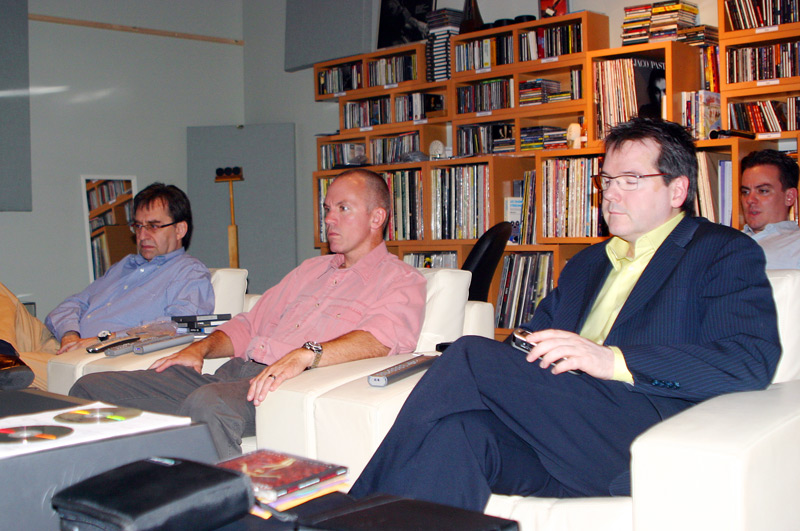
Although measurements and technical proficiency are key factors when Verity Audio
creates a loudspeaker, the final product is shaped by the designers’ listening
experience.
. . . Jeff Fritz
jeff@ultraaudio.com
|